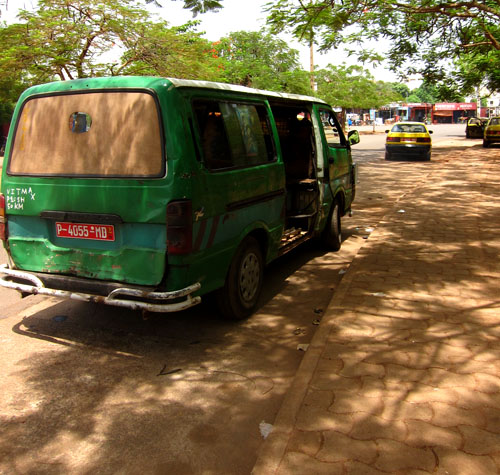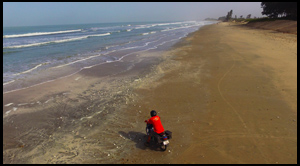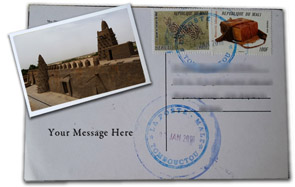Many of the countries in West Africa are former French colonies. The currency used in these countries is the FCFA (Franc Communauté Financière Africaine), more commonly known as the CFA (pronounced seefa). Tied to the Euro at a rate of roughly 640 CFA to 1 Euro, the CFA currency is often cited as the main reason French West Africa is expensive for travelers. How expensive is it?
That depends. Francophone West Africa certainly can be expensive. On average, the anglophone countries in the region are much cheaper.
But it is not prohibitively expensive by any means and it is actually quite cheap if you take the right approach. In a post last fall, I noted that I spent $140 total (not including a visa to Mali) for my month in Cote d’Ivoire.
In this post I’m going to break down my expenses on my current trip (Senegal briefly and now, Mali). Figures will also reflect my time in Mali and Cote d’Ivoire last year, and to a lesser extent, time in Burkina, Togo and Benin 6 years ago.
Visas
No tourist visa is needed for Senegal (true for US, Canada, European citizens as long as duration is 3 months or less). I bought a Malian visa at the border for 15,000 CFA (roughly $33 USD). It is valid for one month. In a week or so, I will get a new visa at immigration for another month. UPDATE: Mali is no longer issuing visas on arrival. This is an unfortunate development that you should be aware of before traveling. You have to get your visa sorted before you arrive in the country.
Visas can be a burden in West Africa, and you certainly need to plan for them. Unfortunately, there is not a convenient service like estapermits that can help you navigate all of the nonsense.
Accommodation
This is where you can break the bank if you are not careful. In Dakar, I stayed in a dorm at the Kingz Plaza Auberge for 4,000 CFA a night (roughly $9). If I went for a private room, the price would have increased to roughly $45.
In Bamako, I stayed at The Sleeping Camel when I first arrived. Again, I stayed in the dorm. Again, it cost 4,000 CFA. At The Sleeping Camel, private rooms are also significantly more expensive, but the dorm is comfortable and clean, and it suits me just fine (I have written about the greatness that is the Sleeping Camel previously in this post).
Now I am in an apartment and I am paying 120,000 CFA a month ($260 dollars). I have 2 bedrooms, a living room, bathroom, a/c, wi-fi, and access to the swimming pool. I will say that it is hard to find accommodation like this for 120,000 CFA. There was some luck involved. That said, you can easily find a one room apartment with your own bathroom, kitchen and air conditioning for 150,000 CFA a month ($330). If you don’t need a private bathroom or a/c, you can find a place for 50,000 CFA a month or less, depending on the integrity of the structure etc. (10,000 CFA a month is possible if you don’t mind a leaky roof).
Another possibility: homestays and couchsurfing. I didn’t do much couchsurfing in Mali the first time around, mostly because I was moving around the country and the Sleeping Camel was simply great, but I couchsurfed in Cote d’Ivoire. In fact, I couchsurfed for a month straight in Cote d’Ivoire.
I don’t know of a formal approach to homestays, but once you get to Mali or anywhere really, it is easy to make friends. Once you make friends you can ask about available rooms, friends of friends, family friends etc., and make an arrangement.
If you want the private hotel room with a/c and bathroom, you’re going to pay for it.
Food and Drink
Again, depends on your approach. At hotels and restaurants serving western food, the prices are going to be much higher. In fact, some places will have prices that are on par with those of the western world.
But you can also eat cheaply. Very cheaply. And you can do so without missing out on delicious food. This is my breakfast:

A large, ripe and delicious mango costs 50-100 CFA (roughly 10-20 cents). A container of yogurt costs 200 CFA (roughly 40 cents).
For lunch, I may have tigadigana (also known as sauce arachide or mafé). This is a sweet and spicy peanut based sauce that is slow cooked with pieces of beef. It is served with rice. For a large portion that includes meat, expect to pay 300 CFA (roughly 60 cents). This is more than enough for a full meal. I buy this from a roadside vendor who has a popular following in Badalabougou. For the same meal in a restaurant, I would pay 1,500 CFA (roughly $3) at least. Street food. Find the popular vendors and enjoy cheap and delicious food.
Tigadigana.
For soft drinks, expect to pay 300-350 CFA (60-70 cents), 30-40 cents more if you are in a restaurant. Beers are typically 500-700 CFA ($1-1.40), more if you are in a nice club or restaurant (sometimes much more). Bottled water can add up quickly, but you can usually find 1.5L of water for 300-400 CFA (60-80 cents). You can buy .5L sachet waters for 50 CFA (10 cents).
In Bamako, the tap water is treated. Heavily, I might add. Tastes like a swimming pool. But it is safe to drink. Most of the time. After a good rain, the treatment plant can get overwhelmed. In this case, I use a SteriPEN Traveler to treat my water. I also use this in rural areas. And in most cities in West Africa for that matter. In this way, I save money, keep plastic waste to a minimum and avoid intestinal disasters. You can check out my video demonstration and review of the SteriPen Traveler.
Transportation
Taxi prices are negotiable, as they are throughout Africa and much of the developing world. Within a city, expect to pay $1-4 dollars depending on the distance. In Bamako, if you are paying more than 2,000 CFA you are either going very far or you are getting stiffed.
Within Bamako, I mostly walk or take sotramas. Sotramas (discussed here) are Mali’s version of the African minibus. They are not the most comfortable, but they are consistently entertaining and social, and they are incredibly cheap. Within Bamako a ride is 100-150 CFA (20-30 cents).
Sotrama.
For longer intercity trips on a bus, prices range from 7-12,000 CFA ($14-24), depending on the distance.
For long (40 hours long) bus trips, like Dakar to Bamako for example, expect to pay 25,000-30,000 CFA ($50-60)
Activities
You can easily spend a lot of money in this area. If you travel to Timbuktu by hired 4×4, for example, you will end up spending hundreds of dollars. You can take a pinasse up the Niger River to Timbuktu for under $15, however.
In terms of guided tours, the price range is enormous. My recommendation is to take your time, make friends, learn some Bambara and get connected with a guide organically. If you don’t have time, then I would suggest getting in touch with a place like The Sleeping Camel. They have legit guides, one of them is a good friend of mine, and the tours are very well run.
If you show up in Mopti, the jumping off point for tours to Dogon Country, a major tourist attraction in Mali, you are going to be swarmed by self-proclaimed guides and it may be very difficult to get someone legit for a reasonable price.
Other activities: Drumming and dance classes for 4,000 CFA ($8)/hour, sometimes less, sometimes more depending on the quality of the instructor. Concerts are cheap. Last Friday, the cover to see Toumani Diabate, Mali’s most esteemed kora player, was 500 CFA ($1).
In Conclusion
French West Africa can be expensive, but it can just as easily be a budget travel destination. Take your time, make friends, talk to people. This will lower your costs and increase your appreciation for the place.
Have you traveled in in this part of the world? What’s your take?






Wow, thanks for the run down Phil. I would have never thought of visiting French West Africa but this is a great breakdown of costs for housing, food, and activities. I have to admit the tigadigana sounds delicious. While traveling around in Africa can’t be easy, I have to admit it’s growing on me because of all that I am learning from you.
Thanks for the comment Jeremy. I’m glad I’m swaying you in that direction!! 🙂 Tigadigana is delicious. It is one of my favorite dishes in the region.
This is great! I found Senegal and Mali to be far more expensive than the other countries I visited (Burkina, even though it, too, runs on the CFA), Ghana, Cameroon, Madagascar (which is fabulously cheap). I think accommodation is really where it’s difficult to keep the price down; you have to know where the cheap places are or you’ll end up staying somewhere more expensive by default, particularly in Dakar.
I lived off bottled water during my travels (and didn’t feel guilty environmentally because so many people wanted to reuse the bottles), and even that’s pretty cheap. Street food is the bomb! Love it!
I agree about accommodation. That seems to be the area where things can head south in a hurry. You’re right about the bottles being reused, it’s the sachets that end up all over. And bottled water is relatively cheap esp. if you buy a case of it. Thanks for the comment Alexis 🙂
First off, you need to quit posting pictures of the world’s cutest girl in your posts. If Shawna finds this kid, Shawna WILL kidnap and adopt her…I guarantee it. Quit teasing…
Awesome to know the expenses, outside of the Burkina Visas, are not that bad…I planning on falling in love with this part of the world, and don’t want to feel I have to leave because it is cost prohibitive.
So extremely excited!!!!!
haha, I almost kidnapped her myself.. Can’t wait to read about your travels here 🙂 If I am here at the same time we will have to meet up!
Cruelest post ever! Omgosh, that food looks so good! I’m really hungry now. I was thinking of going to Central and South America next, but I’m going to have to rethink that. Cruel, Phil, cruel!
My plan is working…
Wow it looks pretty affordable with the most expensive thing being transportation which is not surprising.
Actually I think accommodation is still the tricky one. Long-haul transportation might look expensive, but when you consider quality of roads and distance covered it is reasonable I think. Short distances and intracity, you won’t pay more than 30-40 cents on minibuses, which is nothing to complain about.
Burkina visa became expensive only last year, it was one of the cheaper ones for a long time. I used to get my multiple entrance 1 year visa locally renewed for sth like 32 euros.
And then it all changed last year in June.
It has to be seen in the context of the French embassy charging Burkinabe 40 000 FCFA (sth 60 euros) to get a visa and then reject it, and still charge the money (processing fee !) and putting a big VISA DENIED stamp in their passport.
a comfy A/c ride with TCV between Bamako and Bobo Dioulasso (BUrkina Faso) was less than 20 euros for a 9hr trip last March (I have not traveled that route since then so it could be more pricey now)
Yeah I was in W. Africa when they raised the price last year. Met a lot of people unaware of the increase who showed up at the border expecting the much lower price. Unpleasant surprise for them… When I was in Burkina in 2005 it was also incredibly cheap.
I was wondering about reasons behind the price increase and it is interesting you bring up visas going the other direction. I thought that they raised the price to cash in on the large international crowds for fespaco, craft fair, and dance+theatre festivals, but perhaps there is more to it than that.
TCV is one of the best bus operations in the region. You can still get that bus for less than 20 euros. Thanks for the comment 🙂
Expense aside, it’s the cerebral malaria that keeps me out. Got malaria in Tanzania, once was enough. Speak fluent french so would like to go but obviously cautious.
This is a useful update, thanks.
I’ve had malaria twice, both times treated with coartem which provided relief within 8-12 hours. Cerebral malaria is indeed a scary prospect, but the risk is greatly mitigated if you take antimalarials and you have an Artemisinin based treatment option, like coartem. Thanks for stopping by 🙂
Hello phil.
I am 18 year old swede that wanna move over to Bamako and live there to teach french but also just to travel. and i wonder if i could get your email so that i could ask you a couple of questions, if that would be possible 😉
Thanks in advance
Check your email 🙂